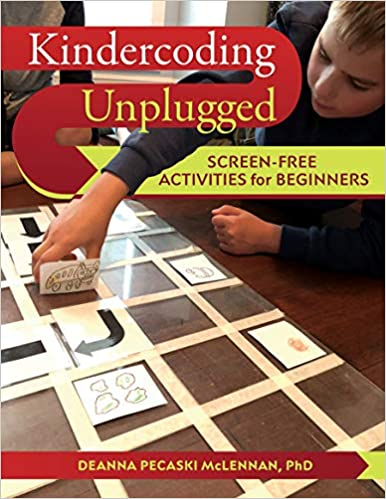early childhood resource review
Kindercoding Unplugged
Screen-Free Activities for Beginners
Science and Children—May/June 2021 (Volume 58, Issue 5)
By Amber Wagner

Kindercoding Unplugged: Screen-Free Activities for Beginners
by Deanna Pecaski McLennan
September 2020
Readleaf Press 184 Pages
$31.45
Kindercoding Unplugged: Screen-Free Activities for Beginners by Deanna Pecaski McLennan explains a variety of activities to help introduce the concept of computational thinking to students ages three to eight. Throughout the text, McLennan provides specific activities to implement in the classroom as well as resource recommendations. Both the activities and resources are low in cost and offer opportunities for students to interact with one another or with supplies (e.g., building blocks, chalk, crafts) in a safe and engaging manner. All activity descriptions include a list of materials, instructions, observations, and next steps.
In Chapter 1, McLennan introduces the idea of unplugged coding, connecting it to the use of physical maps and making a case for why teaching unplugged coding is important, which leads to her relating computational thinking to Reggio Emilia in Chapter 2. She writes with enthusiasm and passion, clearly displaying a strong belief in her approach.
McLennan begins to introduce detailed activities to use in the classroom in Chapter 3. For example, she explains how to introduce algorithms by using a coding grid (paper), arrows (paper), and small figurines. Touching on aspects of patterns and design from the Next Generation Science Standards, she asks students to determine how to direct one figurine (such as a wolf) across a grid to some pre-determined endpoint (marked with plastic fruit). Students have to plot a course using arrows to direct the wolf to the fruit. McLennan then provides a list of questions to observe and assess the activity along with next steps.
The activities provided throughout Chapter 4 focus on engineering design (i.e., exploring and creating Rube Goldberg machines) and problem solving (e.g., inventing something to improve a problem in the classroom). Chapter 5 connects computational thinking with community, encouraging students to connect the mapping they have been doing such as with the coding grid activity described previously to how communities are mapped. One such activity that touches on modeling is to map the community using crayons, pencils, markers, large paper (e.g., butcher paper), boxes and other recycled materials, and other loose parts as well as a tablet or computer. After going on a walk in the community, students are asked to map their walk, filling in a grid on the large paper with details of their walk such as trees, vehicles, and mailboxes. Students can then share their maps and provide guidance on how to reach various destinations, demonstrating their ability to understand how to use models to represent the community.
McLennan does an excellent job tying computational thinking to art in Chapter 6 covering topics such as patterns and design engineering. Topics include binary numbers and American Standard Code for Information Interchange (ASCII) representations along with color mixing algorithms and musical composition. One creative activity explores ASCII representation using beads. For example, the word cat is broken down into the binary number (0s and 1s) for each letter, and a bead for each 0/1 is placed on a pipe cleaner to create a bracelet. Observations including how students choose to organize information and self-correct when making an error are important assessment suggestions.
Chapter 7 connects coding to literacy through story progressions. Several creative activities are suggested that reinforce students’ understanding of storylines and sequencing. Chapter 8 connects coding to math. One particularly insightful activity uses a pre-drawn diagram to assist students in sorting dice. The diagram forces students to walk through an actual computer science sorting algorithm in a very simple and intuitive way where two dice are compared at a time until they are all placed on the other side of the diagram in sorted order.
Throughout the entire book, engaging activities encouraging computational thinking are presented. These activities will provide a strong foundation for understanding computer code while building problem-solving skills and reinforcing concepts such as using models, understanding patterns, and design engineering. Teachers will find the activities to be very low cost and easy to implement in the classroom. ●
Amber Wagner (anwagner@bsc.edu) is a professor in applied computer science at Birmingham-Southern College in Birmingham, Alabama. She has taught grades 7–12 and often provides outreach opportunities in the K–12 space.
Computer Science Instructional Materials Technology Early Childhood


